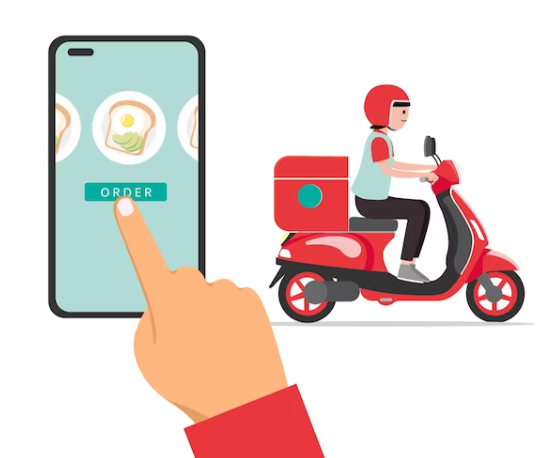Certainly, many food businesses have observed that food delivery apps have changed the dining scene in recent years. Many companies use the latest trends to craft their food apps, which helps them stay ahead of the increasing competition and provide a better customer experience.
It has made it more convenient for users to dine outside or order something delivered to their doorsteps. The fact that this is the most preferred and ordered service by users inspired many entrepreneurs to develop their apps.
However, this is one of many reasons businesses are willing to craft a food delivery app. Thus, let’s explore the other interesting factors that attract most start-ups to this app. We will also discuss the monetization models and the investment needed to create them.
Reasons Why Food Delivery App Is A Great Start-Up Idea For A Business
Data Insights To Optimize The Business
With data analytics, businesses can view their data, identify areas for improvement, and improve the flow and structure of the app. Data analytics can help businesses improve their platform performance by furnishing insights into user experience, preferences, performance matrics, and other vital data points. This can help identify areas for improvement and make informed decisions. This insight can help businesses improve service and predict users’ future demands.
Expand Customer Base
Food delivery apps can help businesses increase their customer base and improve profitability by providing convenience to their customers. Customers can schedule to dine at the restaurant in advance and avoid the waiting queue. They can even order at their doorsteps if they want. This helps businesses retain and expand their customer base, as customers will likely use their service again. You can even do Location-based marketing, which increases the response rate to a much higher level.
Competitive Edge
Businesses can offer different online delivery options to their users who love convenience and accessibility, attract new users, and retain them in the app. The food delivery app also helps the business stay ahead of increasing competition by providing a user-friendly experience to customers.
It helps create strong connections with your users as they can stay connected and updated about your app. This can even help retain them in the app for a longer period. Plus, an on-demand food app makes customizing the software according to changing needs easier, as it helps the firm scale the platform according to demand.
Convenience In Service Access
It allows them to order from anywhere and deliver their order to their door within a few minutes. They can also track their order and customize the food according to their taste. On-demand food delivery apps have achieved favor as they offer two-way benefits: convenience for users and enterprises.
It aids the firm by raising its user base. Multiple customers can order simultaneously and have the item delivered to their places without hassle in very little time. In offline ordering, they have to wait in the queue for their turn, and there is a chance that the item will not be in stock. Online apps can help them avoid all these problems.
Ease In Operational Expenses
Food delivery apps can help reduce operational costs by automating various tasks and simplifying management. For example, live tracking can help you know in which area your delivery men are available to deliver the food orders and can even track them live while delivering the food. Other features help in this task, such as automated payments, managing the vital documents of drivers and users in the app, and much more. Thus, having an online app makes it easier for the entrepreneur to tackle this problem.
Helps In Building Brand Name
A food delivery app can help businesses create strong and consistent online recognition. A custom app can help create the brand’s unique logo. Apps can enhance the brand’s image and awareness by creating a unique user experience. An offline grocery business doesn’t give your enterprise the exposure that an online platform can provide.
Easy To Up-Sell And Cross-Sell
Food delivery apps help businesses increase thier cross and upsell strategies by helping them follow up with thier customer after a sale by gathering their reviews and feedback.
Monetization Models Of Online Food Delivery Platforms
Developing a White Label Food Ordering App assists in generating multiple revenue channels for your business, which can generate a constant and stable income. Here are some interesting monetization models to know.
- Commission
The business takes its decided commission from all services it furnishes to the customers. Each type of service has a different percentage of the commission. It even profits from the restaurant’s earnings from providing the service through the app.
- High demand prize
There are two different prices for regular and high-demand hours, as the user demand is higher during those periods. At this time of the hour, there is a higher demand for deliveries and staff. Thus, this is the best opportunity to earn more profits from the same service.
- Partnering and advertising
Food delivery apps can earn money by advertising other brands on their platform and charging them to display their ads. Furthermore, partnering with related industries can create new earnings. This can help the company attract new customers and create more earning channels.
- Cancellation fees
The customer is charged if they cancel any of the food they ordered. The admin can set a fixed cancellation fee for customers who cancel and even change the cancellation charges amount whenever needed.
- Premium models
customers pay repeating charges, a monthly or yearly fee, to keep using or accessing the service or online software products. This provides the business with assured profits and can predict possible revenue.
Read more:- How to Create a Professional Social Media Profile?
Estimated Cost Projection Of Food Delivery App Development
The cost of building a food delivery app depends on the firm’s needs and multiple factors, such as the app’s structure, attributes, technology stack, top-notch frameworks, tools needed for the process, the development team’s costs, and the developers’ geographic location. However, the figure can range between $10,000 and $300,000.
If the entrepreneur wants to launch this app for multiple OS users, the rate of creating software for this is slightly higher than for one OS. This is because it requires some tools and expertise.
Further, engaging with a UI/UX designer with good experience will require a good investment, which is essential for a more satisfactory user experience. However, the across-the-board expense always alters throughout the development process.
Bottom Line
While some restaurants operate offline with limited profits, multiple firms want to create a powerful online presence by developing food ordering apps. It further has multiple revenue channels for the business by which it increase the profit levels.


